

An artist and an arts manager invite you to Zoom with them. What happens next?
Bruno Booth and Jeremy Smith have known each other for roughly two years. Each currently live and work on unceded Whudjuk Nyoongar Boodja (Wayalup and North Perth respectively).
The pair have reconnected through the Perth Institute of Contemporary Arts (PICA) where they each currently work. Jeremy commenced as PICA’s General Manager in April this year and Bruno’s work features in upcoming PICA exhibitions and events. Bruno also actively in PICA’s install and visitor experience teams.
Speaking about ‘Creating Space’, Bruno and Jeremy agreed disruption to ‘normal’ was something that allowed space to be made. So instead of coming prepared with a workshop or a presentation to give, we are offering our audience the chance to tell us what we should speak about. Meeting Place unplugged, unhinged, uncoordinated, unstructured… maybe unruly.
Bruno and Jez invite you to tell us what you’d like us to discuss. Read our bio’s – and take your reflections about us, your experiences of our work and practice to flavour your provocations. Questions, topics, conversation starters… it’s all fair game provided the space of our time online remains safe, respectful and positive (for the main) for everyone.
Give us questions to respond to – individually or together, questions to ask one another, word associations – whatever. Be provocative, be intriguing, be bold, be kind, be inquisitive and be prepared… Bruno and Jez reserve the right to turn the tables and also ask questions of you!
Day 2: Wednesday 16 September
Time: TBC
Duration: 60 minutes
Access: Live-captioned; Auslan-interpreted; audiodescribed by presenters
Do you have a question, topic, conversation starter, word association etc for Bruno or Jez? Send it through to info@artsaccessaustralia.org with ‘Thigh to Eye’ in the subject line.

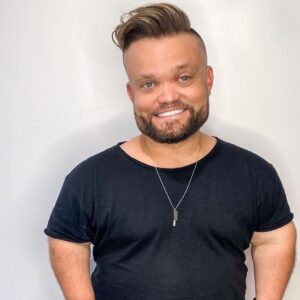 In 2016, at the age of 39, Jeremy first chose to identify as a disabled man. Prior to this, many other chose to label him as such on his behalf (mostly without permission or consent). He now wonders why he waited for such a long time to embrace this part of his identity and enjoy the company and support of the fierce and ferocious accomplices that are part of this community.
In 2016, at the age of 39, Jeremy first chose to identify as a disabled man. Prior to this, many other chose to label him as such on his behalf (mostly without permission or consent). He now wonders why he waited for such a long time to embrace this part of his identity and enjoy the company and support of the fierce and ferocious accomplices that are part of this community.
Not long after his birth, his parents were told by a doctor (who also happened to be a capital city mayor) to make sure he never had children – because achondroplasia (dwarfism) was hereditary.
Teachers at his high school were gravely concerned he wouldn’t ‘make it’ and that being amongst 1800 students would be too overwhelming. He was prefect for four of his five years at high school, and won the inaugural arts prize on graduation.
Lecturers at his university were concerned about his ability to climb a ladder and rig lights. He graduated in 1997 and became a successful lighting designer in Perth.
His tailor has become a close friend due to the amount of time (and money) Jeremy spends.
His working life has seen him work arts, funding, policy, sponsorship and regional development across government, not for profit and corporate sectors. He’s been part of too many equity, diversity, access and inclusion committees to remember. Highlights include being the cover-star (without permission) of a government submission that won a Premier’s Award for inclusion initiatives, and being told his services were not needed for the ‘Project All-Sorts’ steering group – a mining sector initiative for diversity and inclusion- as the priority was on Indigenous employment and women in leadership roles.
He still feels shame when he is out with family and friends and gets made fun of. Not for himself, but for those around him who clearly feel uncomfortable.
He enjoys the challenge of influence. He has a range of tactics that have often delivered outcomes and results that have been positive, crunchy and awkward all at once. One such instance in a recent workplace was sending the entire organisation an email with the subject heading ‘Did you know?’ which outlined the daily occurrences a person with Achondroplasia was subjected to. The email was sent on Dwarfism Awareness Day and was accompanied by a rainbow-coloured unicorn decorated sponge cake for morning tea. Colleagues spoke about the email for months after, and altered their behaviours, attitudes and assumptions in response.
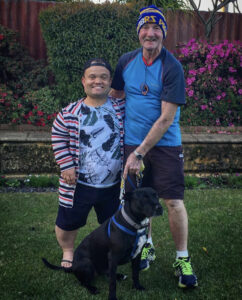
He is inspired by the new genres and aesthetics disabled artists and arts workers bring to their work. Discussions and debates across the sector are always richer when the voice of disabled people is centred.
His career is like a socks and jocks drawer in terms of variety, colour and fragrance. You can see more about his professional career on Jeremy’s LinkedIn page and his number one love Chester, pictured here with his father Jim.
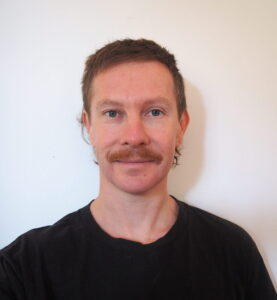
Bruno has used a wheelchair for most of his life, interrupted by a short and unsuccessful career as an amatuer stilt walker when he used prosthetic legs as a child. In his memory these leather and metal devices would not have been out of place on the set of some dystopian, apocalyptic epic – not in a cool and attractive Fury Road sort of way, more like the zombies in the original Walking Dead. The experience of wearing restrictive equipment left him with a dislike of tight fitting clothing, a love of speed and a need to reach over his head in supermarkets – as a child he made the decision to use a wheelchair as his primary mode of transport – and he’s never looked back (probably because he’s too busy looking out for sand pits on dark footpaths).
His parents moved the family from a windswept hill in the UK to tropical, northern Australia and then back again before he started high school. One minute he was floating in a freshwater rockpool watching a leech gorge itself on his arm, the next he’s on a grimy school bus, sporting shapeless waterproof trousers. He went to a standardly rough Lancashire school. Damp brick, polyester blazers, rain and lots of steps – his friends helped him navigate the building, carrying his chair up and down and up and down and up and down ad infinitum. He played in bands during these years, and later in college and should have probably studied art but instead convinced himself that he could be a scientist – he had the grades but lacked the motivation.
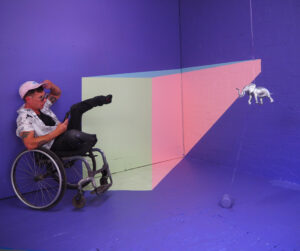
Bruno went to Uni in the UK and studied Environmental Science and Ecology before emigrating back to Australia and working as a Hydrogeologist. He quit this job to play in a band and spent five years playing music and hanging out at Mojos before returning to study graphic design at TAFE. He’s called himself an artist with only a little bit of cringe for the last 4 years and since then has kind of hit his stride (or whatever the rolling equivalent of that is).
Having a disability has been a constant background hum throughout Bruno’s life. Kind of like a social tinnitus – you know it’s there but you try not to talk about it. It was only when he started to call himself an artist, without cringing too much, that he began to engage critically with what it meant to be categorised as disabled.
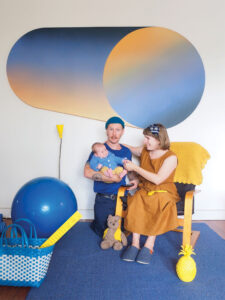
Bruno’s recent work uses participation and large sculptural forms to create experiential works that challenge the able bodied to navigate a world that is uncomfortable by design. His constructed experiences poke fun at the assumptions many people have surrounding disability and yet they also leave lasting impressions that engender a deeper response from the audience.
He has a bunch of cool sounding stuff on his CV (pdf, 34 KB) all of which is nowhere near as important to him as his awesome little family (which you can see here!)